一轮复习课件必修5 Unit 1 Great Scientists 课件(78张)
文档属性
| 名称 | 一轮复习课件必修5 Unit 1 Great Scientists 课件(78张) | 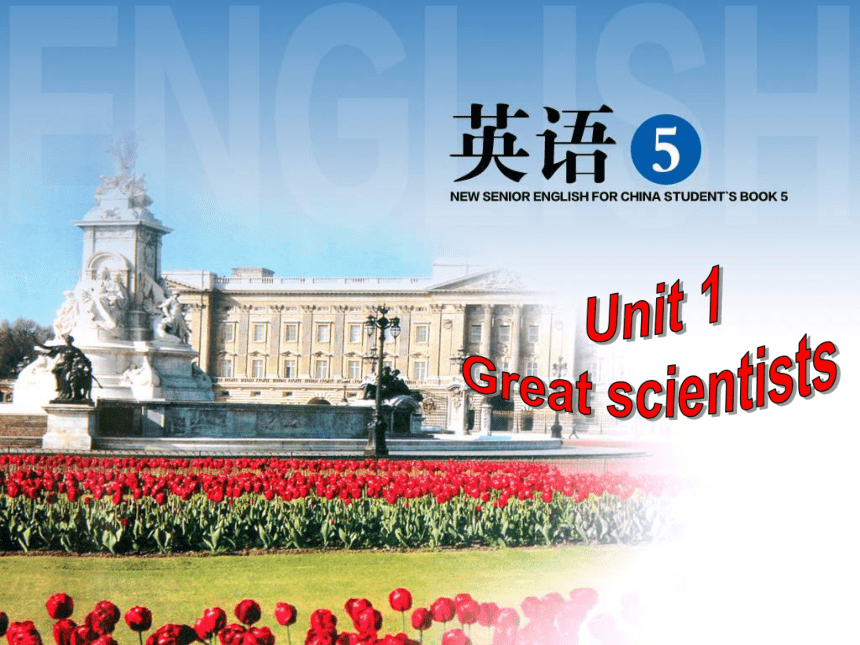 | |
| 格式 | zip | ||
| 文件大小 | 1.1MB | ||
| 资源类型 | 教案 | ||
| 版本资源 | 人教版(新课程标准) | ||
| 科目 | 英语 | ||
| 更新时间 | 2018-12-28 07:51:52 | ||
图片预览

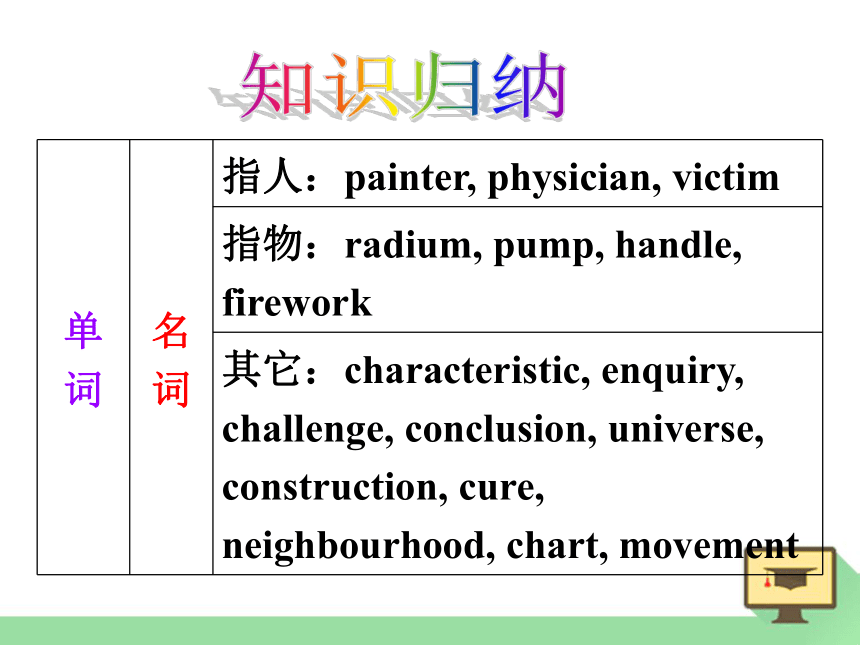
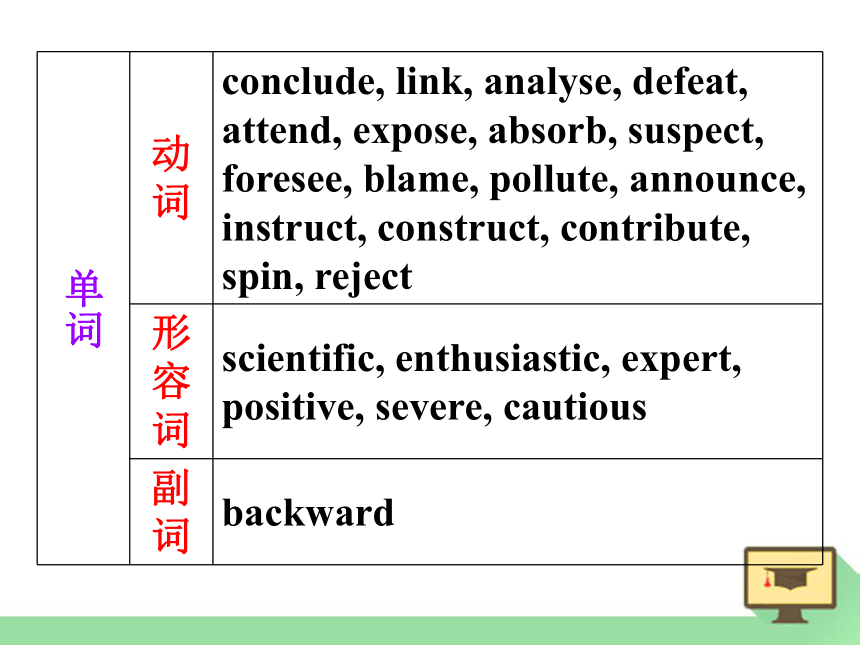
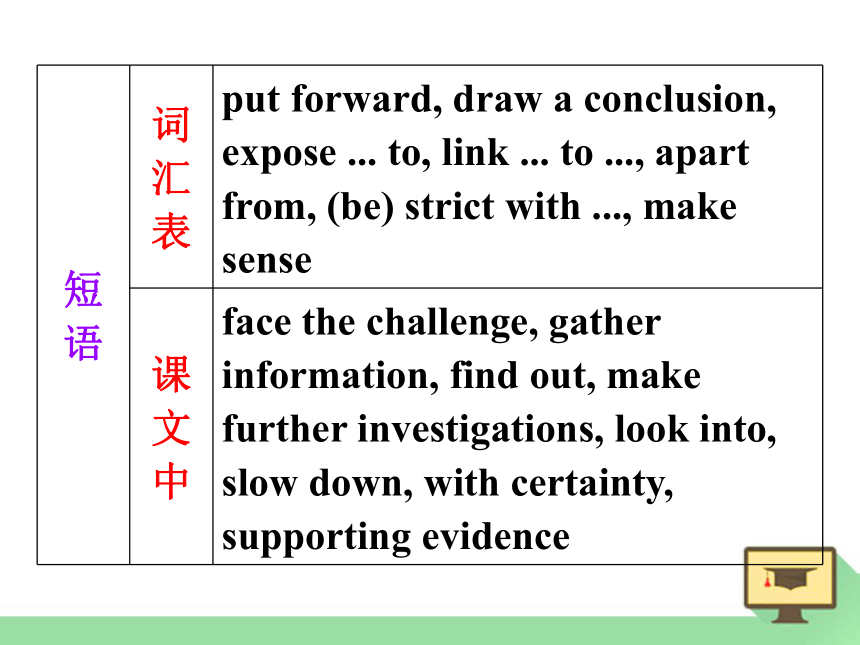
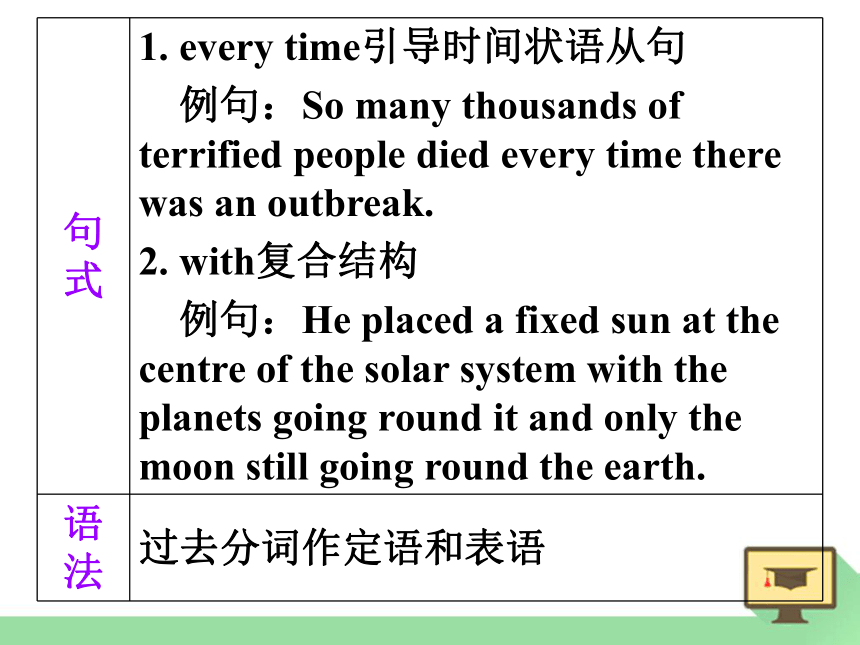
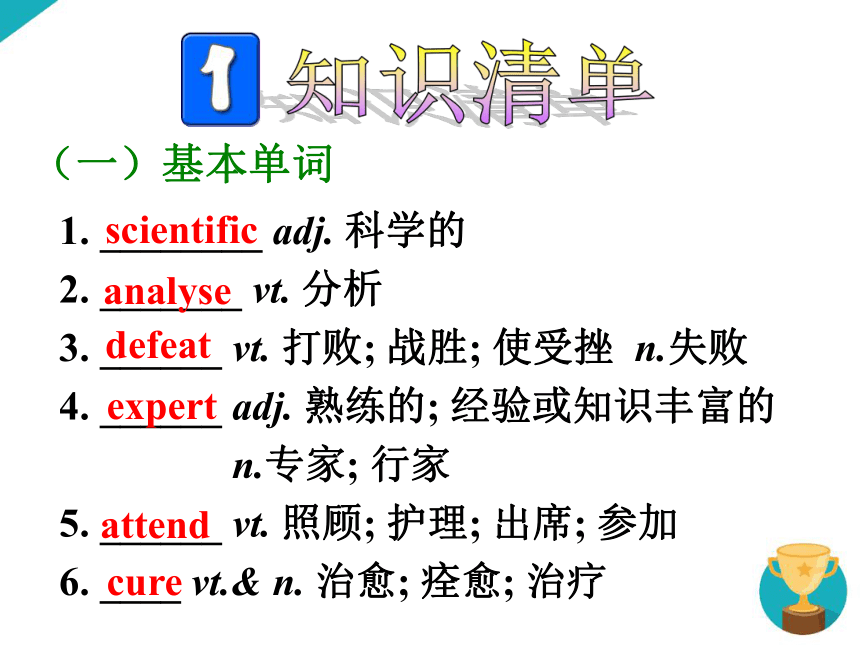

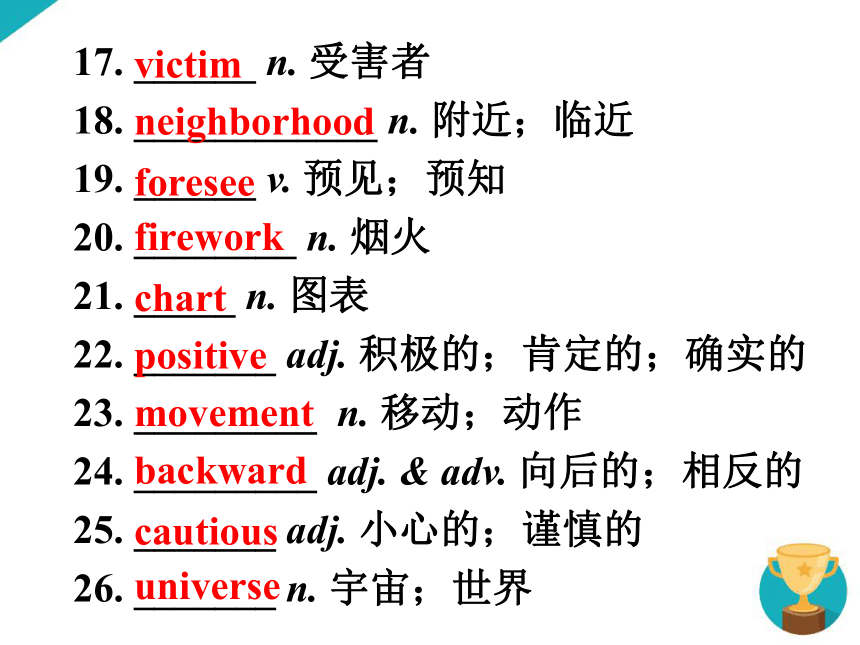
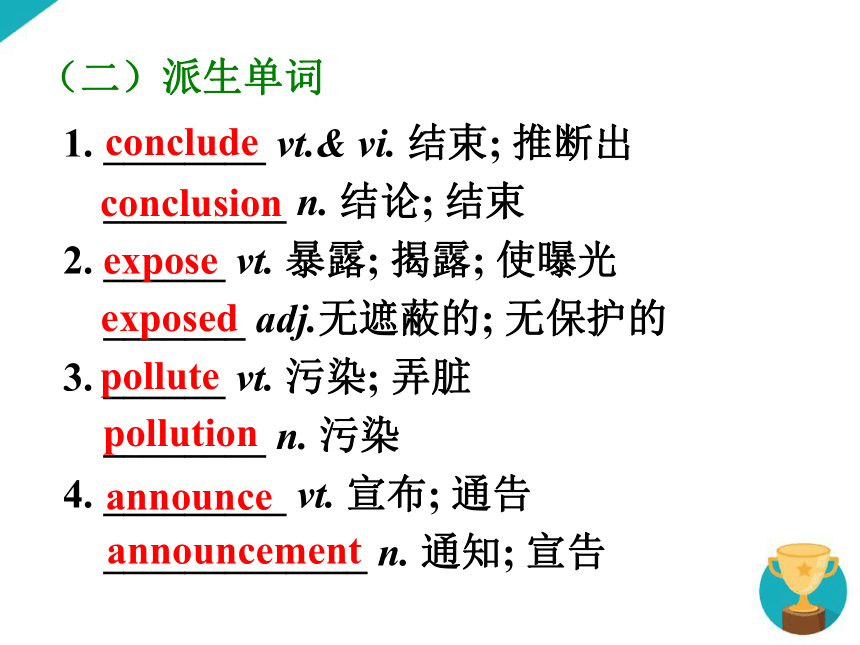
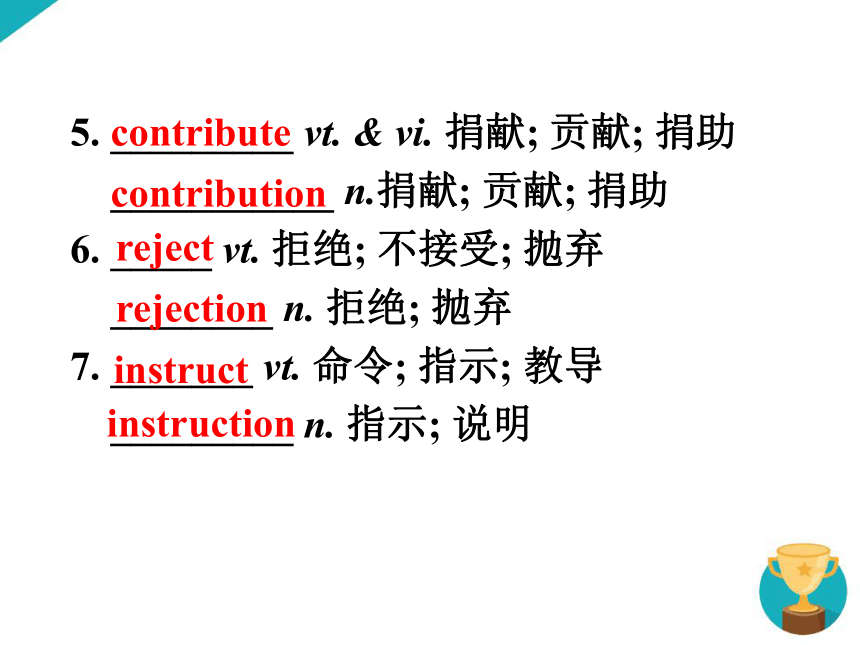
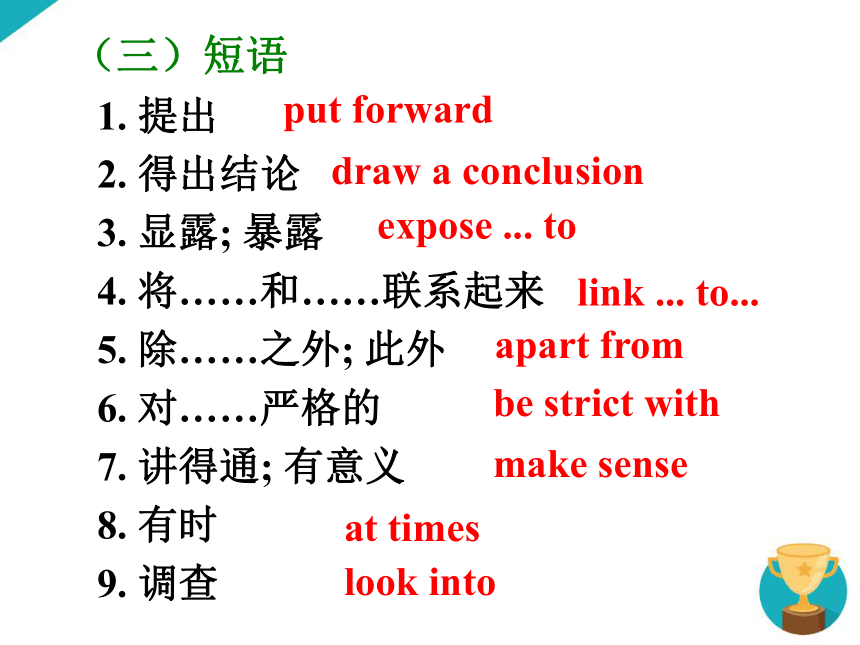
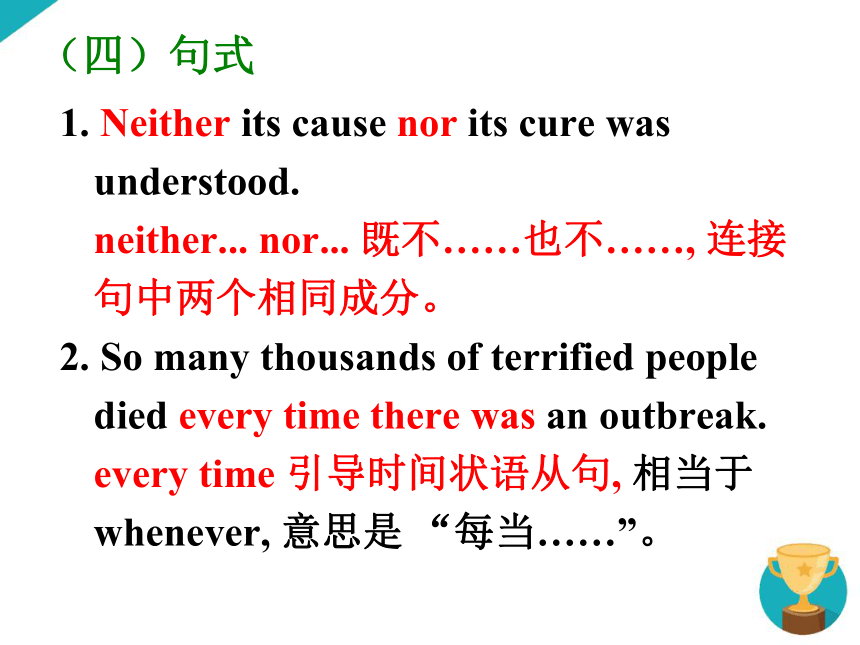
文档简介
单词 名词 指人:painter, physician, victim
指物:radium, pump, handle, firework
其它:characteristic, enquiry, challenge, conclusion, universe, construction, cure, neighbourhood, chart, movement
单词 动词 conclude, link, analyse, defeat, attend, expose, absorb, suspect, foresee, blame, pollute, announce, instruct, construct, contribute, spin, reject
形容词 scientific, enthusiastic, expert, positive, severe, cautious
副词 backward
短语 词汇表 put forward, draw a conclusion, expose ... to, link ... to ..., apart from, (be) strict with ..., make sense
课文中 face the challenge, gather information, find out, make further investigations, look into, slow down, with certainty, supporting evidence
句式 1. every time引导时间状语从句
例句:So many thousands of terrified people died every time there was an outbreak.
2. with复合结构
例句:He placed a fixed sun at the centre of the solar system with the planets going round it and only the moon still going round the earth.
语法 过去分词作定语和表语
1. ________ adj. 科学的
2. _______ vt. 分析
3. ______ vt. 打败; 战胜; 使受挫 n.失败
4. ______ adj. 熟练的; 经验或知识丰富的
n.专家; 行家
5. ______ vt. 照顾; 护理; 出席; 参加
6. ____ vt.& n. 治愈; 痊愈; 治疗
scientific
analyse
defeat
expert
(一)基本单词
attend
cure
7. ________ n. 挑战 vt. 向……挑战
8. ______ vt. 吸收; 吸引; 使专心
9. ______ vt. 怀疑 n. 嫌疑犯
10. ______ adj.严重的; 剧烈的; 严厉的
11. _____ vt. 责备; 谴责 n. 过失; 责备
12. ______ n. 柄; 把手 vt. 处理; 操纵
13. ____ vi.& vt. (使) 旋转; 纺(线或纱)
14. __________ adj. 热情的; 热心的
15. ____________ n. 特征; 特性
16. ________ n. 医生; 内科医生
challenge
absorb
suspect
severe
blame
handle
spin
enthusiastic
characteristic
physician
17. ______ n. 受害者
18. ____________ n. 附近;临近
19. ______ v. 预见;预知
20. ________ n. 烟火
21. _____ n. 图表
22. _______ adj. 积极的;肯定的;确实的
23. _________ n. 移动;动作
24. _________ adj. & adv. 向后的;相反的
25. _______ adj. 小心的;谨慎的
26. _______ n. 宇宙;世界
victim
neighborhood
foresee
firework
chart
positive
movement
backward
cautious
universe
1. ________ vt.& vi. 结束; 推断出
_________ n. 结论; 结束
2. ______ vt. 暴露; 揭露; 使曝光
_______ adj.无遮蔽的; 无保护的
3. ______ vt. 污染; 弄脏
________ n. 污染
4. _________ vt. 宣布; 通告
_____________ n. 通知; 宣告
conclude
conclusion
expose
exposed
pollute
pollution
(二)派生单词
announce
announcement
5. _________ vt. & vi. 捐献; 贡献; 捐助
___________ n.捐献; 贡献; 捐助
6. _____ vt. 拒绝; 不接受; 抛弃
________ n. 拒绝; 抛弃
7. _______ vt. 命令; 指示; 教导
_________ n. 指示; 说明
contribute
contribution
reject
rejection
instruct
instruction
1. 提出
2. 得出结论
3. 显露; 暴露
4. 将……和……联系起来
5. 除……之外; 此外
6. 对……严格的
7. 讲得通; 有意义
8. 有时
9. 调查
put forward
draw a conclusion
expose ... to
link ... to...
(三)短语
apart from
be strict with
make sense
at times
look into
(四)句式
1. Neither its cause nor its cure was understood.
neither... nor... 既不……也不……, 连接句中两个相同成分。
2. So many thousands of terrified people died every time there was an outbreak.
every time 引导时间状语从句, 相当于whenever, 意思是 “每当……”。
3. A woman, who had moved away from Broad Street, liked the water from the pump so much that she had it delivered to her house every day.
have sth. done 结构。delivered是过去分词, 作it的宾语补足语, 表示被动关系。
1. conclude vt. & vi. 结束; 推断出
(课文原句) Draw a conclusion
翻译:得出结论
(一)单词
conclusion n. 结论; 结束
归纳
sth. (from sth.)
conclude 推断出;断定
(from sth.) that...
with/on/as/by sth.
conclude sth 以......结束
by doing sth.
draw/ reach /come to a conclusion 得出结论
in conclusion 最后
2. defeat vt.打败; 战胜; 使受挫 n.失败
(课文原句) John Snow defeats “King Cholera”
翻译:约翰斯诺击败“霍乱王”
辨析defeat/ beat/ win
defeat和beat是同义词, 其宾语为人或团体, 常可互换。defeat侧重在战场上打败敌人。beat常用于游戏或比赛中。
win后接sth.,表示在较强的竞争中取得了胜利, 宾语多用game, war, prize等词, 不能是人; win也可用作不及物动词, “赢, 获胜”。
3. attend vt.& vi.出席; 参加; 照顾; 专心;
陪伴
(课文原句) John Snow was a well-known doctor in London – so expert, that he attended Queen Victoria as her personal physician.
翻译:约翰斯诺是伦敦一位著名的医生——他的确医术精湛,因而成为照料维多利亚女皇的私人医生。
归纳
attend a meeting/a lecture/a wedding
参加会议/ 听演讲/ 参加婚礼
attend on/upon sb. 伺候某人;照顾某人
attend to 处理; 注意倾听; 专心于; 照料
4. expose v. 暴露; 揭露; 使曝光
(课文原句) But he became inspired when he thought about helping ordinary people exposed to cholera.
翻译:但当他想到要帮助那些得了霍乱的普通百姓时,他就感到很振奋。
归纳
expose sth. 揭露;显露出某事物
expose sth./ sb./ oneself (to sth.)
使某事/某人/自己暴露/显露
expose sb. to sth. 让某人接触某物
be exposed to 暴露于……
【温馨提示】
expose sth. to… to是介词, 后接名词或动名词作宾语。
5. cure n. 治愈; 痊愈 vt.治愈; 治疗; 解决
(课文原句) Neither its cause nor its cure was understood.
翻译:人们既不知道它的病源,也不了解它的治疗方法。
归纳
cure for sth. 治疗……的方法
cure sb. of sth.
治愈某人的疾病; 矫正某人的不良行为
辨析 cure/ treat/ heal
cure “治疗, 治愈”, 多用于药物治疗并治愈某种疾病或改正不良习惯。cure sb. of sth.
treat 治疗病人的全过程或活动, 并不涉及“治愈” 这个结果。treat sb. for sth.
heal 指治好外伤或烧伤后的患部 (wound, cut, injury, burn, etc.), 使伤口愈合; heal不能用来表示 “感冒” 等疾病的治愈。
6. challenge n. 挑战
vt. 向……挑战
(课文原句) John Snow wanted to face the challenge and solve this problem.
翻译:约翰斯诺想面对这个挑战,解决这个问题。
归纳
face / meet the challenge of ... 面临/迎接……的挑战
take up / accept a challenge接受挑战
拓展
challenger n. 挑战者
challenging adj. 挑战性的
7. suspect
suspect作动词时,意为“以为,怀疑”,常用结构:suspect + that从句;suspect sb. / sth. to be ...;suspect sb. of doing sth.。
suspect作名词时,意为“嫌疑犯”。
suspect作形容词时,意为“可疑的,不可信的”。
(课文原句) John Snow suspected that the second theory was correct but he needed evidence.
翻译:斯诺推测第二种说法是正确的,但是他需要证据。
8. absorb v. 吸收; 吸引; 使专心
(课文原句) The second suggested that people absorbed this disease into their bodies with their meals.
翻译:第二种看法是在吃饭的时候人们把这种病毒引入体内的。
归纳
absorb ... into 把……吸收进
absorb ... from 从……中吸收/取
be absorbed in (doing) sth. 专心(做)某事
absorb one’s attention 吸引某人注意力
【温馨提示】
be absorbed in (专心于) , 主语往往是人, 并不表示被动, 类似短语有: be buried in 专心于; be lost in 陷入; be caught in 被困于; be devoted to 致力于。
9. blame v. 责备; 谴责; 把……归咎于
n. 过失; 责备
(课文原句) It seemed that the water was to blame.
翻译:看来水是罪魁祸首。
归纳
blame sb. for sth. /doing sth.
因……而指责某人
blame ... on sb. 把......归咎于某人
be to blame (for sth.) (主动表被动) 应受责备
accept/ bear/ take the blame for sth.
对某事承担责任
put/ lay the blame for sth. on sb.
把某事归咎于某人
10. contribute v. 捐献; 贡献; 捐助
(课文原句) to contribute (P4)
归纳
contribute ... to ...
把……贡献给……;向……投稿
contribute to ...
导致……; 有助于……; 为……作贡献
make a contribution/contributions to...
为……作出贡献
1. put forward 提出; 推荐;把(表)往前拨;
提前
(二)短语
(课文原句) Who put forward a theory about black holes?
翻译:谁提出的黑洞理论?
【温馨提示】
在表示“提出”时, put forward和comeup with 同义,都为及物动词语。come up也有提出的意思, 是不及物动词短语。
拓展
put aside 节省; 储蓄; 储存
put away 放好; 积蓄
put off 延期; 推迟
put on 穿上; 演出
put out 熄灭; 生产
put up 举起; 张贴; 公布; 挂起; 建造
2. link ... to ... 将……和……连接/ 联系起来
(课文原句) In another part of London, he found supporting evidence from two other deaths that were linked to the Broad Street outbreak.
翻译:在伦敦的另一个地区,他从两个与宽街暴发的霍乱有关系的死亡病例中发现了有力的证据。
拓展
be linked to 和……有联系
link up (with) 连接; 结合; 有联系
link ... with 用…… 把……连接起来; 联系
join ... to 把……与……连接/ 联合
connect ... to 把……连接到……
connect ... with 把……与……联系/连接起来
be connected with 与……有联系
3. apart from 除……之外; 此外
(课文原句) Apart from the construction mentioned above, you have also learned the following phrases.
翻译:除了上面提到的结构,下面这些短语也是你学过的。
辨析
apart from “除了……之外”, 可意为包括在内, 也可意为不包括在内。
other than “除了……”, 用于否定句。
in addition用于衔接上下文, 可单独用于句首, 也可以用于句中或句尾, 用于句首或句中时要用逗号隔开。
in addition to, as well as, besides
除……之外(还有) (包括在内)。
except, except for, but
除……之外 (不包括在内)。
except + 从句 当……时除外
4. make sense 有意义; 讲得通
(课文原句) Only if you put the sun there did the movements of the other planets in the sky make sense.
翻译:只有当你把太阳放在中心位置上,天空中其他行星的运动才能说得清楚。
拓展
make sense of 理解; 明白
make no sense 没道理; 没意义
there is no sense in doing sth. 做某事没道理
in a sense 在某一方面; 就某种意义来说
in no sense 决不
sense of humor 幽默感
【温馨提示】
in no sense 置句首时, 句子用部分倒装。
See,?your?computer?has?broken?down?again!?It?doesn’t?___?sense?to?buy?the?cheapest?
brand?of?computer?just?to?save?a?few?dollars.
(2015天津卷)?
A.?have???B.?make????C.?display???D.?bring?
考点:考查动词短语。?
句意:看,你的电脑又坏了!只为省几美元买最便宜牌子的电脑是没有意义的。考查动词短语的固定搭配:make?sense有意义。根据句意可知选B。?
B
1. Neither its cause nor its cure was understood.
人们既不知道它的起因, 又不知道它的治疗方法。
neither... nor... 既不……也不, 连接句中两个相同成分。
(三)句式
拓展
类似并列词组还有:
either... or... 要么……要么……
not... but... 不是……而是……
not only... but also… 不但……而且……
它们连接并列主语时, 其谓语动词的单复数都遵循就近原则。(主谓一致)
e.g. Either you or she is good at drawing.
Neither dad nor mum is at home
today.
Not only the students but also their
teacher is enjoying the film.
2. So many thousands of terrified people died every time there was an outbreak.
每次爆发霍乱时, 都有大批惊恐的老百姓病死。
every time引导时间状语从句, 相当于whenever, 意思是“每当……”。
由名词充当连词, 引导时间状语从句的还有: the first time (第一次), the last time (最后一次), next time (下次), the moment (一……就), any time (任何时候) 等。
e.g.
Every time Tom listens to her advice, he gets into trouble.
每次汤姆听从了她的建议, 就会陷入麻烦。
Every time he came, he brought me a nice book.
他每次来都给我带来一本好书。
3. A woman, who had moved away from Broad Street, liked the water from the pump so much that she had it delivered to her house every day.
有一位妇女是从宽街搬过来的, 她特别喜欢那里的水, 每天都要派人用水泵打水运到家里来。
have sth. done 结构。delivered是过去分词, 作it的宾语补足语, 表示被动关系。
过去分词作定语和表语
★过去分词作定语
【用法归纳】
1. 过去分词作定语,一般表示其与所修饰的名词之间是被动关系,且表示的动作已完成。
如:
You’d better use the boiled water to make tea.
The nurse was sent to attend the injured man.
2. 单个的过去分词作定语一般放在名词前面,而过去分词短语作定语一般放在名词后面。如:
Drunk people are not allowed to drive a car.
Have you read the novel written by Charles Dickens?
In the end, the suggestion given by Mr. Smith was adopted.
3. 不及物动词的过去分词作定语,只表示完成的含义,不表示被动的含义。如:
The police are searching for the escaped prisoner.
The old man over there is a retired worker.
【拓展】
done, to be done和being done 作定语的区别:它们都可作定语,表示被动意义,但时间含义上有所不同。过去分词表示被动的动作已完成;不定式的被动式表示被动的动作将要发生;动词-ing形式的被动式表示被动的动作正在进行。如:
Lucy knows little about the research plan discussed at yesterday’s meeting.
The five players are expected to take part in the football match to be held next week.
All of us must keep a secret of the things being talked about here.
★过去分词作表语
【用法归纳】
1. 过去分词可用在be, keep, remain, stay, seem, appear, look, feel, get等系动词后作表语,常表被动意义,用来说明主语的状态、性质、特征等。如:
Mrs. Green is convinced that her husband is telling a lie.
The living room is covered with dust.
2. 很多过去分词已经形容词化,此类词作表语或定语时,强调被动的含义不大,而更强调状态。常见的此类词有:satisfied, excited, bored, amazed, tired, pleased, astonished等。如:
As far as Tom is concerned, he is extremely satisfied.
Jim seems astonished to see his mother.
【拓展】
有些动词如frighten, interest, worry, surprise等通常用其过去分词形式来说明人的感受,也可用来描述与人有关的事物,如look (表情),expression等;常用动词-ing形式来说明物的情况。如:
The little girl gets frightened when her father shouts at her.
Sara told me a surprising thing just now.?
There?were?many?people?waiting?at?the?bus
stop,?and?some?of?them?looked?very?
anxious?and?______________?(disappoint?). ?(?2014新课标全国卷II?)?
修饰人的情绪时用V-ed形式。
disappointed?????
There?are?still?many?problems?__________?(solve)?before?we?are?ready?for?a?long?stay?on?the?Moon.?(2014?北京)?
本题考查非谓语动词作定语。句意:在我们准备好在月球上长久停留之前,仍然还有许多问题有待解决。根据句意可知“这些问题还未解决”,to?be?solved既表被动又表将来。
to?be?solved???
用括号内所给单词的正确形式填空。
1. I found myself in an ____________ (embarrass) situation last night.
2. The thief tried to open the ________ (lock) box.
3. The ________ (expect) event didn’t occur.
4.? The ________ (injure) woman was sent to hospital quickly.
embarrassing
locked
expected
injured?
5. We need a(n) ________ (balance) diet in order to keep fit.
6. The dragon was a(n) ________ (terrify) sight for the villagers. The ________ (terrify) villagers ran for their lives.
balanced
terrifying
terrified
如何写说服性议论文
【写作任务】
假如你们班将在英语课上围绕“是否存在外星人”这一话题进行辩论,你将作为正方代表发言。请用英语写一篇发言稿。
注意:词数120左右。
【写作指导】
1. 审题定调
这是一篇说服性议论文。要求针对“是否存在外星人”这一话题,提出自己的见解和看法,并阐述自己的理由。写作时要注意内容上的科学性、表达上的逻辑性、结构上的条理性和语言上的准确性。
2. 确定主体内容
此类写作通常包括以下几方面的内容:首先,阐明自己的观点;然后,列举自己的理由;最后,进行总结。
针对这篇习作的主题,可以把全文分为三段:
第一段:阐明观点——外星人是存在的;
第二段:列举理由——有关于外星人的影片、报道及科学发展的可能性和无限性;
第三段:进行总结,并再次陈述自己的观点。
3. 确定人称、时态
表达自己的观点多用第一人称;时态以一般现在时为主。
4. 常用表达
The reason for ... is that ...
The reasons for ... are as follows. First, ...
Second, ... Last but not the least, ...
What’s more ... / Furthermore ...
If ..., how can ...?
Therefore / Thus ...
On the one hand, ...; on the other hand ...
【参考范文】
Dear classmates,
We are strongly of the opinion that there are aliens in the universe. The reasons are as follows.
Most of us have seen the famous movie ET, which is a story about an alien. Actually, newspapers have also reported that people have seen real creatures like aliens and flying machines called UFOs several times in the daily lives. If there are no aliens, how can people describe their experiences so vividly?
Furthermore, compared to the rest of the universe, the ability of we human beings is so limited that we surely haven’t found out about all of its mysteries. Therefore, with the development of science and our hard work, maybe we will confirm the existence of aliens in the near future by discovering some new evidence.
In short, please believe that aliens surely exist in the universe.
I.?用括号内单词的正确形式填空。
1. His company made a very large _____________ (contribute) to the program.
2. I've always been ________ (caution) about giving people my phone number.??????
contribution
cautious
3. Mrs. Edwards gave the worker _____________ (instruct) on how to operate the machine.
4. Mendes led a(n) __________ (move) to stop the cutting down of the rain forest.
5. The company will finance the ____________ (construct) of a new community sports centre.
instructions?
movement
construction
II.?选用合适的动词并用其正确形式填空
(每个单词限用一次)。
excite, speak, frighten, seat, select, retire
1. The players ________ from the whole country are expected to bring us honour in this summer game.
2. I'm very ________ about the possibility of playing for?England's best team.
3. I found it hard to understand the English ________ by the native villagers.
selected?
excited
spoken?
excite, speak, frighten, seat, select, retire
4. Most of these ________ workers have found a part-time job to earn some money.
5. I got very ___________ when he lost his temper.
6. Ladies and gentlemen, please remain ________ until the plane has come to a complete stop.
retired
frightened
seated
阅读下面材料,在空白处填入适当的内容(1个单词)或括号内单词的正确形式。
C.V. Raman, a great Indian physicist, was born in 1888. His father was a lecturer in mathematics and physics, so C.V. Raman was exposed 1. ________ scientific things from 2. ______ early age. He attended?Presidency?College?in 1902, getting his BA in 1904 and an MA in 1907.
to ?
an?
Though a brilliant student, 3. ________ weren't many opportunities for scientists in?India?at that time. Therefore, after concluding his studies, he went to work for the Indian Finance Department and carried 4. ________ his experimental research in acoustics and optics (声学和光学) after work in the laboratory of the Indian Association for the Cultivation of Science.
there
out??
He 5. ___________ (offer) a professorship in physics at?Calcutta?University?in 1917 and stayed for the next 15 years, 6. ________ (achieve) fame for his research there. In 1930, he won the Nobel Prize for his work on the scattering (散射) of light. Raman found 7. ______ when light passes through a transparent (透明的) sample of a substance, most of the light remains unchanged but a small part of it has 8. ________ (differ) wavelengths.
was offered
achieving?
that ?
different?
This later became 9. ________ (know) as the Raman effect and is useful for physical and chemical 10. ________ (analyse) of gases, liquids and solids, including biological tissue.
C.V. Raman died in 1970.
known
analysis
指物:radium, pump, handle, firework
其它:characteristic, enquiry, challenge, conclusion, universe, construction, cure, neighbourhood, chart, movement
单词 动词 conclude, link, analyse, defeat, attend, expose, absorb, suspect, foresee, blame, pollute, announce, instruct, construct, contribute, spin, reject
形容词 scientific, enthusiastic, expert, positive, severe, cautious
副词 backward
短语 词汇表 put forward, draw a conclusion, expose ... to, link ... to ..., apart from, (be) strict with ..., make sense
课文中 face the challenge, gather information, find out, make further investigations, look into, slow down, with certainty, supporting evidence
句式 1. every time引导时间状语从句
例句:So many thousands of terrified people died every time there was an outbreak.
2. with复合结构
例句:He placed a fixed sun at the centre of the solar system with the planets going round it and only the moon still going round the earth.
语法 过去分词作定语和表语
1. ________ adj. 科学的
2. _______ vt. 分析
3. ______ vt. 打败; 战胜; 使受挫 n.失败
4. ______ adj. 熟练的; 经验或知识丰富的
n.专家; 行家
5. ______ vt. 照顾; 护理; 出席; 参加
6. ____ vt.& n. 治愈; 痊愈; 治疗
scientific
analyse
defeat
expert
(一)基本单词
attend
cure
7. ________ n. 挑战 vt. 向……挑战
8. ______ vt. 吸收; 吸引; 使专心
9. ______ vt. 怀疑 n. 嫌疑犯
10. ______ adj.严重的; 剧烈的; 严厉的
11. _____ vt. 责备; 谴责 n. 过失; 责备
12. ______ n. 柄; 把手 vt. 处理; 操纵
13. ____ vi.& vt. (使) 旋转; 纺(线或纱)
14. __________ adj. 热情的; 热心的
15. ____________ n. 特征; 特性
16. ________ n. 医生; 内科医生
challenge
absorb
suspect
severe
blame
handle
spin
enthusiastic
characteristic
physician
17. ______ n. 受害者
18. ____________ n. 附近;临近
19. ______ v. 预见;预知
20. ________ n. 烟火
21. _____ n. 图表
22. _______ adj. 积极的;肯定的;确实的
23. _________ n. 移动;动作
24. _________ adj. & adv. 向后的;相反的
25. _______ adj. 小心的;谨慎的
26. _______ n. 宇宙;世界
victim
neighborhood
foresee
firework
chart
positive
movement
backward
cautious
universe
1. ________ vt.& vi. 结束; 推断出
_________ n. 结论; 结束
2. ______ vt. 暴露; 揭露; 使曝光
_______ adj.无遮蔽的; 无保护的
3. ______ vt. 污染; 弄脏
________ n. 污染
4. _________ vt. 宣布; 通告
_____________ n. 通知; 宣告
conclude
conclusion
expose
exposed
pollute
pollution
(二)派生单词
announce
announcement
5. _________ vt. & vi. 捐献; 贡献; 捐助
___________ n.捐献; 贡献; 捐助
6. _____ vt. 拒绝; 不接受; 抛弃
________ n. 拒绝; 抛弃
7. _______ vt. 命令; 指示; 教导
_________ n. 指示; 说明
contribute
contribution
reject
rejection
instruct
instruction
1. 提出
2. 得出结论
3. 显露; 暴露
4. 将……和……联系起来
5. 除……之外; 此外
6. 对……严格的
7. 讲得通; 有意义
8. 有时
9. 调查
put forward
draw a conclusion
expose ... to
link ... to...
(三)短语
apart from
be strict with
make sense
at times
look into
(四)句式
1. Neither its cause nor its cure was understood.
neither... nor... 既不……也不……, 连接句中两个相同成分。
2. So many thousands of terrified people died every time there was an outbreak.
every time 引导时间状语从句, 相当于whenever, 意思是 “每当……”。
3. A woman, who had moved away from Broad Street, liked the water from the pump so much that she had it delivered to her house every day.
have sth. done 结构。delivered是过去分词, 作it的宾语补足语, 表示被动关系。
1. conclude vt. & vi. 结束; 推断出
(课文原句) Draw a conclusion
翻译:得出结论
(一)单词
conclusion n. 结论; 结束
归纳
sth. (from sth.)
conclude 推断出;断定
(from sth.) that...
with/on/as/by sth.
conclude sth 以......结束
by doing sth.
draw/ reach /come to a conclusion 得出结论
in conclusion 最后
2. defeat vt.打败; 战胜; 使受挫 n.失败
(课文原句) John Snow defeats “King Cholera”
翻译:约翰斯诺击败“霍乱王”
辨析defeat/ beat/ win
defeat和beat是同义词, 其宾语为人或团体, 常可互换。defeat侧重在战场上打败敌人。beat常用于游戏或比赛中。
win后接sth.,表示在较强的竞争中取得了胜利, 宾语多用game, war, prize等词, 不能是人; win也可用作不及物动词, “赢, 获胜”。
3. attend vt.& vi.出席; 参加; 照顾; 专心;
陪伴
(课文原句) John Snow was a well-known doctor in London – so expert, that he attended Queen Victoria as her personal physician.
翻译:约翰斯诺是伦敦一位著名的医生——他的确医术精湛,因而成为照料维多利亚女皇的私人医生。
归纳
attend a meeting/a lecture/a wedding
参加会议/ 听演讲/ 参加婚礼
attend on/upon sb. 伺候某人;照顾某人
attend to 处理; 注意倾听; 专心于; 照料
4. expose v. 暴露; 揭露; 使曝光
(课文原句) But he became inspired when he thought about helping ordinary people exposed to cholera.
翻译:但当他想到要帮助那些得了霍乱的普通百姓时,他就感到很振奋。
归纳
expose sth. 揭露;显露出某事物
expose sth./ sb./ oneself (to sth.)
使某事/某人/自己暴露/显露
expose sb. to sth. 让某人接触某物
be exposed to 暴露于……
【温馨提示】
expose sth. to… to是介词, 后接名词或动名词作宾语。
5. cure n. 治愈; 痊愈 vt.治愈; 治疗; 解决
(课文原句) Neither its cause nor its cure was understood.
翻译:人们既不知道它的病源,也不了解它的治疗方法。
归纳
cure for sth. 治疗……的方法
cure sb. of sth.
治愈某人的疾病; 矫正某人的不良行为
辨析 cure/ treat/ heal
cure “治疗, 治愈”, 多用于药物治疗并治愈某种疾病或改正不良习惯。cure sb. of sth.
treat 治疗病人的全过程或活动, 并不涉及“治愈” 这个结果。treat sb. for sth.
heal 指治好外伤或烧伤后的患部 (wound, cut, injury, burn, etc.), 使伤口愈合; heal不能用来表示 “感冒” 等疾病的治愈。
6. challenge n. 挑战
vt. 向……挑战
(课文原句) John Snow wanted to face the challenge and solve this problem.
翻译:约翰斯诺想面对这个挑战,解决这个问题。
归纳
face / meet the challenge of ... 面临/迎接……的挑战
take up / accept a challenge接受挑战
拓展
challenger n. 挑战者
challenging adj. 挑战性的
7. suspect
suspect作动词时,意为“以为,怀疑”,常用结构:suspect + that从句;suspect sb. / sth. to be ...;suspect sb. of doing sth.。
suspect作名词时,意为“嫌疑犯”。
suspect作形容词时,意为“可疑的,不可信的”。
(课文原句) John Snow suspected that the second theory was correct but he needed evidence.
翻译:斯诺推测第二种说法是正确的,但是他需要证据。
8. absorb v. 吸收; 吸引; 使专心
(课文原句) The second suggested that people absorbed this disease into their bodies with their meals.
翻译:第二种看法是在吃饭的时候人们把这种病毒引入体内的。
归纳
absorb ... into 把……吸收进
absorb ... from 从……中吸收/取
be absorbed in (doing) sth. 专心(做)某事
absorb one’s attention 吸引某人注意力
【温馨提示】
be absorbed in (专心于) , 主语往往是人, 并不表示被动, 类似短语有: be buried in 专心于; be lost in 陷入; be caught in 被困于; be devoted to 致力于。
9. blame v. 责备; 谴责; 把……归咎于
n. 过失; 责备
(课文原句) It seemed that the water was to blame.
翻译:看来水是罪魁祸首。
归纳
blame sb. for sth. /doing sth.
因……而指责某人
blame ... on sb. 把......归咎于某人
be to blame (for sth.) (主动表被动) 应受责备
accept/ bear/ take the blame for sth.
对某事承担责任
put/ lay the blame for sth. on sb.
把某事归咎于某人
10. contribute v. 捐献; 贡献; 捐助
(课文原句) to contribute (P4)
归纳
contribute ... to ...
把……贡献给……;向……投稿
contribute to ...
导致……; 有助于……; 为……作贡献
make a contribution/contributions to...
为……作出贡献
1. put forward 提出; 推荐;把(表)往前拨;
提前
(二)短语
(课文原句) Who put forward a theory about black holes?
翻译:谁提出的黑洞理论?
【温馨提示】
在表示“提出”时, put forward和comeup with 同义,都为及物动词语。come up也有提出的意思, 是不及物动词短语。
拓展
put aside 节省; 储蓄; 储存
put away 放好; 积蓄
put off 延期; 推迟
put on 穿上; 演出
put out 熄灭; 生产
put up 举起; 张贴; 公布; 挂起; 建造
2. link ... to ... 将……和……连接/ 联系起来
(课文原句) In another part of London, he found supporting evidence from two other deaths that were linked to the Broad Street outbreak.
翻译:在伦敦的另一个地区,他从两个与宽街暴发的霍乱有关系的死亡病例中发现了有力的证据。
拓展
be linked to 和……有联系
link up (with) 连接; 结合; 有联系
link ... with 用…… 把……连接起来; 联系
join ... to 把……与……连接/ 联合
connect ... to 把……连接到……
connect ... with 把……与……联系/连接起来
be connected with 与……有联系
3. apart from 除……之外; 此外
(课文原句) Apart from the construction mentioned above, you have also learned the following phrases.
翻译:除了上面提到的结构,下面这些短语也是你学过的。
辨析
apart from “除了……之外”, 可意为包括在内, 也可意为不包括在内。
other than “除了……”, 用于否定句。
in addition用于衔接上下文, 可单独用于句首, 也可以用于句中或句尾, 用于句首或句中时要用逗号隔开。
in addition to, as well as, besides
除……之外(还有) (包括在内)。
except, except for, but
除……之外 (不包括在内)。
except + 从句 当……时除外
4. make sense 有意义; 讲得通
(课文原句) Only if you put the sun there did the movements of the other planets in the sky make sense.
翻译:只有当你把太阳放在中心位置上,天空中其他行星的运动才能说得清楚。
拓展
make sense of 理解; 明白
make no sense 没道理; 没意义
there is no sense in doing sth. 做某事没道理
in a sense 在某一方面; 就某种意义来说
in no sense 决不
sense of humor 幽默感
【温馨提示】
in no sense 置句首时, 句子用部分倒装。
See,?your?computer?has?broken?down?again!?It?doesn’t?___?sense?to?buy?the?cheapest?
brand?of?computer?just?to?save?a?few?dollars.
(2015天津卷)?
A.?have???B.?make????C.?display???D.?bring?
考点:考查动词短语。?
句意:看,你的电脑又坏了!只为省几美元买最便宜牌子的电脑是没有意义的。考查动词短语的固定搭配:make?sense有意义。根据句意可知选B。?
B
1. Neither its cause nor its cure was understood.
人们既不知道它的起因, 又不知道它的治疗方法。
neither... nor... 既不……也不, 连接句中两个相同成分。
(三)句式
拓展
类似并列词组还有:
either... or... 要么……要么……
not... but... 不是……而是……
not only... but also… 不但……而且……
它们连接并列主语时, 其谓语动词的单复数都遵循就近原则。(主谓一致)
e.g. Either you or she is good at drawing.
Neither dad nor mum is at home
today.
Not only the students but also their
teacher is enjoying the film.
2. So many thousands of terrified people died every time there was an outbreak.
每次爆发霍乱时, 都有大批惊恐的老百姓病死。
every time引导时间状语从句, 相当于whenever, 意思是“每当……”。
由名词充当连词, 引导时间状语从句的还有: the first time (第一次), the last time (最后一次), next time (下次), the moment (一……就), any time (任何时候) 等。
e.g.
Every time Tom listens to her advice, he gets into trouble.
每次汤姆听从了她的建议, 就会陷入麻烦。
Every time he came, he brought me a nice book.
他每次来都给我带来一本好书。
3. A woman, who had moved away from Broad Street, liked the water from the pump so much that she had it delivered to her house every day.
有一位妇女是从宽街搬过来的, 她特别喜欢那里的水, 每天都要派人用水泵打水运到家里来。
have sth. done 结构。delivered是过去分词, 作it的宾语补足语, 表示被动关系。
过去分词作定语和表语
★过去分词作定语
【用法归纳】
1. 过去分词作定语,一般表示其与所修饰的名词之间是被动关系,且表示的动作已完成。
如:
You’d better use the boiled water to make tea.
The nurse was sent to attend the injured man.
2. 单个的过去分词作定语一般放在名词前面,而过去分词短语作定语一般放在名词后面。如:
Drunk people are not allowed to drive a car.
Have you read the novel written by Charles Dickens?
In the end, the suggestion given by Mr. Smith was adopted.
3. 不及物动词的过去分词作定语,只表示完成的含义,不表示被动的含义。如:
The police are searching for the escaped prisoner.
The old man over there is a retired worker.
【拓展】
done, to be done和being done 作定语的区别:它们都可作定语,表示被动意义,但时间含义上有所不同。过去分词表示被动的动作已完成;不定式的被动式表示被动的动作将要发生;动词-ing形式的被动式表示被动的动作正在进行。如:
Lucy knows little about the research plan discussed at yesterday’s meeting.
The five players are expected to take part in the football match to be held next week.
All of us must keep a secret of the things being talked about here.
★过去分词作表语
【用法归纳】
1. 过去分词可用在be, keep, remain, stay, seem, appear, look, feel, get等系动词后作表语,常表被动意义,用来说明主语的状态、性质、特征等。如:
Mrs. Green is convinced that her husband is telling a lie.
The living room is covered with dust.
2. 很多过去分词已经形容词化,此类词作表语或定语时,强调被动的含义不大,而更强调状态。常见的此类词有:satisfied, excited, bored, amazed, tired, pleased, astonished等。如:
As far as Tom is concerned, he is extremely satisfied.
Jim seems astonished to see his mother.
【拓展】
有些动词如frighten, interest, worry, surprise等通常用其过去分词形式来说明人的感受,也可用来描述与人有关的事物,如look (表情),expression等;常用动词-ing形式来说明物的情况。如:
The little girl gets frightened when her father shouts at her.
Sara told me a surprising thing just now.?
There?were?many?people?waiting?at?the?bus
stop,?and?some?of?them?looked?very?
anxious?and?______________?(disappoint?). ?(?2014新课标全国卷II?)?
修饰人的情绪时用V-ed形式。
disappointed?????
There?are?still?many?problems?__________?(solve)?before?we?are?ready?for?a?long?stay?on?the?Moon.?(2014?北京)?
本题考查非谓语动词作定语。句意:在我们准备好在月球上长久停留之前,仍然还有许多问题有待解决。根据句意可知“这些问题还未解决”,to?be?solved既表被动又表将来。
to?be?solved???
用括号内所给单词的正确形式填空。
1. I found myself in an ____________ (embarrass) situation last night.
2. The thief tried to open the ________ (lock) box.
3. The ________ (expect) event didn’t occur.
4.? The ________ (injure) woman was sent to hospital quickly.
embarrassing
locked
expected
injured?
5. We need a(n) ________ (balance) diet in order to keep fit.
6. The dragon was a(n) ________ (terrify) sight for the villagers. The ________ (terrify) villagers ran for their lives.
balanced
terrifying
terrified
如何写说服性议论文
【写作任务】
假如你们班将在英语课上围绕“是否存在外星人”这一话题进行辩论,你将作为正方代表发言。请用英语写一篇发言稿。
注意:词数120左右。
【写作指导】
1. 审题定调
这是一篇说服性议论文。要求针对“是否存在外星人”这一话题,提出自己的见解和看法,并阐述自己的理由。写作时要注意内容上的科学性、表达上的逻辑性、结构上的条理性和语言上的准确性。
2. 确定主体内容
此类写作通常包括以下几方面的内容:首先,阐明自己的观点;然后,列举自己的理由;最后,进行总结。
针对这篇习作的主题,可以把全文分为三段:
第一段:阐明观点——外星人是存在的;
第二段:列举理由——有关于外星人的影片、报道及科学发展的可能性和无限性;
第三段:进行总结,并再次陈述自己的观点。
3. 确定人称、时态
表达自己的观点多用第一人称;时态以一般现在时为主。
4. 常用表达
The reason for ... is that ...
The reasons for ... are as follows. First, ...
Second, ... Last but not the least, ...
What’s more ... / Furthermore ...
If ..., how can ...?
Therefore / Thus ...
On the one hand, ...; on the other hand ...
【参考范文】
Dear classmates,
We are strongly of the opinion that there are aliens in the universe. The reasons are as follows.
Most of us have seen the famous movie ET, which is a story about an alien. Actually, newspapers have also reported that people have seen real creatures like aliens and flying machines called UFOs several times in the daily lives. If there are no aliens, how can people describe their experiences so vividly?
Furthermore, compared to the rest of the universe, the ability of we human beings is so limited that we surely haven’t found out about all of its mysteries. Therefore, with the development of science and our hard work, maybe we will confirm the existence of aliens in the near future by discovering some new evidence.
In short, please believe that aliens surely exist in the universe.
I.?用括号内单词的正确形式填空。
1. His company made a very large _____________ (contribute) to the program.
2. I've always been ________ (caution) about giving people my phone number.??????
contribution
cautious
3. Mrs. Edwards gave the worker _____________ (instruct) on how to operate the machine.
4. Mendes led a(n) __________ (move) to stop the cutting down of the rain forest.
5. The company will finance the ____________ (construct) of a new community sports centre.
instructions?
movement
construction
II.?选用合适的动词并用其正确形式填空
(每个单词限用一次)。
excite, speak, frighten, seat, select, retire
1. The players ________ from the whole country are expected to bring us honour in this summer game.
2. I'm very ________ about the possibility of playing for?England's best team.
3. I found it hard to understand the English ________ by the native villagers.
selected?
excited
spoken?
excite, speak, frighten, seat, select, retire
4. Most of these ________ workers have found a part-time job to earn some money.
5. I got very ___________ when he lost his temper.
6. Ladies and gentlemen, please remain ________ until the plane has come to a complete stop.
retired
frightened
seated
阅读下面材料,在空白处填入适当的内容(1个单词)或括号内单词的正确形式。
C.V. Raman, a great Indian physicist, was born in 1888. His father was a lecturer in mathematics and physics, so C.V. Raman was exposed 1. ________ scientific things from 2. ______ early age. He attended?Presidency?College?in 1902, getting his BA in 1904 and an MA in 1907.
to ?
an?
Though a brilliant student, 3. ________ weren't many opportunities for scientists in?India?at that time. Therefore, after concluding his studies, he went to work for the Indian Finance Department and carried 4. ________ his experimental research in acoustics and optics (声学和光学) after work in the laboratory of the Indian Association for the Cultivation of Science.
there
out??
He 5. ___________ (offer) a professorship in physics at?Calcutta?University?in 1917 and stayed for the next 15 years, 6. ________ (achieve) fame for his research there. In 1930, he won the Nobel Prize for his work on the scattering (散射) of light. Raman found 7. ______ when light passes through a transparent (透明的) sample of a substance, most of the light remains unchanged but a small part of it has 8. ________ (differ) wavelengths.
was offered
achieving?
that ?
different?
This later became 9. ________ (know) as the Raman effect and is useful for physical and chemical 10. ________ (analyse) of gases, liquids and solids, including biological tissue.
C.V. Raman died in 1970.
known
analysis
